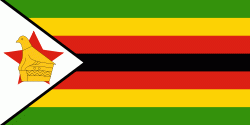Matabeleland North (Matabeleland North Province)
Matabeleland North is bordered by Matabeleland South and Bulawayo to the south, Midlands to the east, Mashonaland West to the northeast, Botswana to the west, and Zambia to the north, which is separated from Zimbabwe by the Zambezi river. It has an area of 75,025 km2, equal to 19.2% of the total area of Zimbabwe. It is the largest in area of the country's ten provinces. Matabeleland North is located on the edge of the Kalahari Basin, giving it an arid climate. Its economy is dominated by agriculture, with 83% of employed people in the province working as farmers. Cattle ranching and tourism also contribute to the economy. The Zimbabwean side of Victoria Falls, a World Heritage Site and major tourist attraction, is located in Matabeleland North.
The region of Matabeleland, of which Matabeleland North is a part of, is characterized by generally inhospitable land when compared to other parts of Zimbabwe. It has lower rainfall than provinces such as Mashonaland, and is plagued by water scarcity in general. The land is also less fertile than other provinces, as commercial crops cannot be grown and rural farmers usually cannot produce enough maize to feed their families. However, during the colonial era, large numbers of cattle ranches were formed and cattle ranching has proved to be more successful than growing crops in the province. The upper reaches of the Nata River flow through Matabeleland North before entering Botswana to discharge to the Makgadikgadi Pans.
The region does have a significant amount of other resources like gold, limestone, methane gas, coal, and timber. As seen in Hwange National Park, Zimbabwe's largest game reserve, the area is also known for its substantial wildlife population. However, the most famous geographic feature of Matebeleland North is Victoria Falls, the world's largest waterfalls that are located on the Zambezi river on the northern border of the province.
Map - Matabeleland North (Matabeleland North Province)
Map
Country - Zimbabwe
 |
 |
| Flag of Zimbabwe | |
The British South Africa Company of Cecil Rhodes demarcated the Rhodesia region in 1890 when they conquered Mashonaland and later in 1893 Matabeleland after a fierce resistance by Matabele people known as the First Matabele War. Company rule ended in 1923 with the establishment of Southern Rhodesia as a self-governing British colony. In 1965, the white minority government unilaterally declared independence as Rhodesia. The state endured international isolation and a 15-year guerrilla war with black nationalist forces; this culminated in a peace agreement that established universal enfranchisement and de jure sovereignty as Zimbabwe in April 1980. Zimbabwe then joined the Commonwealth of Nations, from which it was suspended in 2002 for breaches of international law by its government under Robert Mugabe and from which it withdrew in December 2003.
Currency / Language
| ISO | Currency | Symbol | Significant figures |
|---|---|---|---|
| ZWL | Zimbabwean dollar | 2 |
| ISO | Language |
|---|---|
| SN | Shona language |















